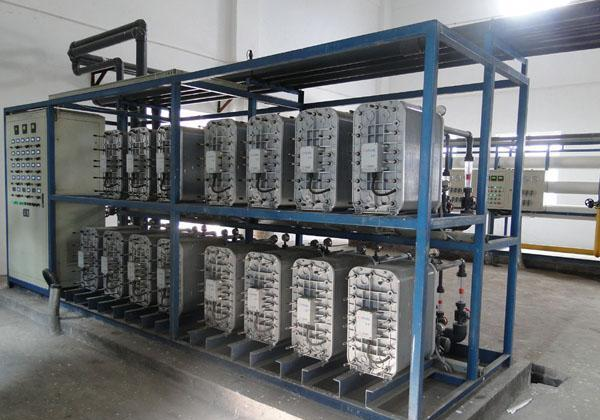Equipment Introduction
Continuous Electrodeionization:
Utilizes ion-exchange membranes and resin beds to remove ions from water continuously, eliminating the need for chemical regeneration and reducing operational costs.
High Purity Output:
Delivers ultrapure water with resistivity up to 18.2 MΩ·cm (at 25°C) and extremely low levels of total organic carbon (TOC), silica, and microbial contaminants.
Integrated Reverse Osmosis (RO) Pre-Treatment:
Includes RO technology to remove dissolved solids, colloids, and organics, extending the lifespan of the EDI module and ensuring consistent performance.
Advanced Monitoring & Control:
Equipped with PLC automation and real-time sensors for continuous monitoring of water quality parameters, flow rates, pressure, and system status.
Compact & Modular Design:
Space-saving configuration allows for easy integration into existing water treatment systems or new installations.
Energy-Efficient Operation:
Optimized power consumption and reduced water waste compared to traditional ion-exchange systems.
Low Maintenance Requirements:
Minimized downtime with self-cleaning functions and long-lasting components.

Working Principle
1. Pre-Treatment Stage
Reverse Osmosis (RO) Filtration: Feedwater first passes through an RO system to remove 95–99% of dissolved solids, organics, and colloids. This protects the EDI module from fouling and extends its lifespan.
Carbon Filtration: Optional step to remove chlorine, chloramines, and residual organics that could damage EDI components.
2. EDI Module Operation
Resin Bed Ion Exchange:The pre-treated water enters the EDI module, which contains alternating compartments filled with cation and anion exchange resins. These resins attract and capture ions (e.g., sodium, chloride, silica) from the water.
Electrical Regeneration: A DC voltage applied across the module creates an electric field. This field drives captured ions through ion-selective membranes (cationic or anionic) into adjacent "concentrate" compartments, where they are flushed away in a separate stream.
Water Splitting: At high electric potentials, water molecules in the resin beds split into hydrogen (H⁺) and hydroxide (OH⁻) ions. These ions continuously regenerate the resin beds in-situ, eliminating the need for external chemical regenerants (e.g., acids or caustic soda).
3. Ultrapure Water Production
Ion Removal: As water flows through the resin-filled compartments, ions are progressively removed, achieving resistivity levels up to 18.2 MΩ·cm (the theoretical limit for ultrapure water).
Polishing Stage: Final polishing removes trace contaminants, ensuring compliance with strict industry standards (e.g., SEMI F74 for semiconductor-grade water).
4. Key Advantages of EDI
Continuous Operation:Unlike batch-based ion-exchange systems, EDI runs 24/7 without downtime for regeneration.
Chemical-Free: Reduces environmental impact by eliminating hazardous acid/caustic waste.
Energy-Efficient: Lower power consumption compared to distillation or electrodeionization alone.
Consistent Quality:Maintains stable resistivity and low TOC/particulate levels.
Compact Design: Modular configuration saves floor space in industrial settings.
5. Typical Applications
Semiconductor Manufacturing: Rinsing microchips to prevent ionic contamination.
Pharmaceuticals: Preparing water for injections (WFI) and sterile drug formulations.
Power Generation: Boiler feedwater to prevent scaling and corrosion.
Electronics: Cleaning precision components like LCD panels.
Specifications and Parameters
Technical Parameters
Flow Range: 0~48,000 m³/h
Cylinder Height: 1~24 m
Head Range: ≤100 m
Control Power: Single pump ≤315 kW/380 V; ≤1,000 kW/10 kV
Cylinder Diameter: ≤10 m
Cylinder Material: GRP (Glass Reinforced Plastic); Stainless Steel
Application Scope
1.Sponge City Construction
2.Sewerage Interception and Pipeline Network Project
3.Black and Odorous Water Body Treatment
4.Rainwater and Sewage Diversion Project
5.Rural Domestic Sewage Treatment
6.Water Environment Ecological Restoration Project